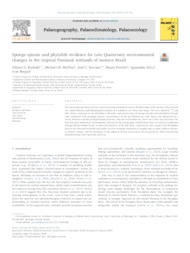Sponge spicule and phytolith evidence for Late Quaternary environmental changes in the tropical Pantanal wetlands of western Brazil.
Sponge spicule and phytolith evidence for Late Quaternary environmental changes in the tropical Pantanal wetlands of western Brazil.
Author(s): RASBOLD, G. G.; McGLUE, M. M.; STEVAUX, J. C.; PAROLIN, M.; SILVA, A.; BERGIER, I.
Summary: The environmental history of the central Pantanal wetlands of western Brazil is inferred for the last 19 kyrs based on a multi-indicator paleolimnological analysis of a sediment core from Lake Negra. The core, dated by 14C and OSL, shows variations in the abundance, diversity, and preservation of sponge spicules and phytoliths through time, consistent with changing aquatic environments. In the late Pleistocene, Lake Negra was influenced by a strong monsoon and fluvial depositional processes, whereas in the Holocene, there was a drier interval where the lake was more isolated on the floodplain. Hiatuses in the stratigraphy resulted from both wet and dry conditions, through fluvial channel scour or subaerial exposure of the lake floor, respectively. Data suggest that floodplain lakes in the Pantanal wetlands and similar riverine wetlands respond in a complex and, at times, indirect manner to climate change, and the dynamics of the adjacent fluvial system must be accounted for when interpreting paleohydrology and vegetation patterns.
Publication year: 2019
Types of publication: Journal article
Unit: Embrapa Pantanal
Keywords: Climate change, Ecologia, Lago, Lakes, Mudança Climática, Paleoecology, Wetland conservation
Observation
Some of Embrapa's publications are published as ePub files. To read them, use or download one of the following free software options to your computer or mobile device. Android: Google Play Books; IOS: iBooks; Windows and Linux: Calibre.
Access other publications
Access the Agricultural Research Database (BDPA) to consult Embrapa's full library collection and records.
Visit Embrapa Bookstore to purchase books and other publications sold by Embrapa.

